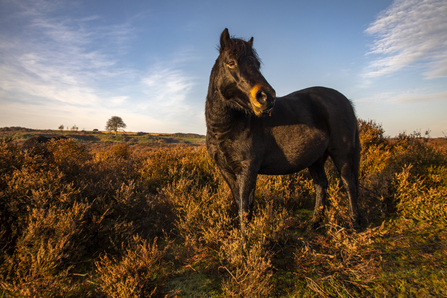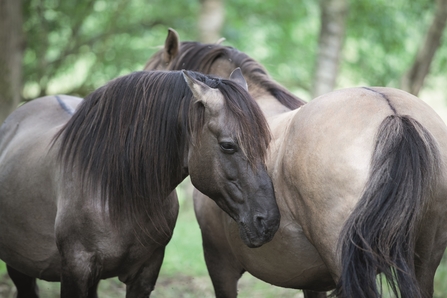
East Wretham Heath wild pony (credit: Jimmy King)
Ponies
We keep two breeds of pony in Norfolk, both with very different origins, each helping us to manage different types of habitat.
Dartmoor pony
Anyone who has visited Dartmoor will have noticed the Dartmoor ponies, an endangered breed that is as much a part of the landscape as the moor itself.
Ponies have been found on Dartmoor for centuries, in fact hoof prints found at an archaeological dig suggest they have been there for 3500 years. In more recent times, the ponies have been used to transport granite, as pit ponies and even to escort prisoners across the moor!
Their calm nature, combined with their ability to thrive on relatively poor quality grazing means they also make excellent conservation graziers and are considered essential to maintain the open mosaic of habitats for which Dartmoor is so famous.
In Norfolk the ponies have found an equally important role, helping us to look after large areas of heathland throughout the county. In the Brecks, our largest single herd of ponies, some 50 animals, graze alternatively on Hockwold and Weeting Heaths. An open sward is essential here to ensure the right conditions for nesting stone curlew. In the spring we carefully monitor potential nesting activity, excluding ponies from such areas to allow the birds to nest safely. At other times of the year the ponies graze quite intensively, breaking up the sward to enable rare Breckland flora, such as spiked speedwell and Spanish catchfly to thrive.
At Buxton Heath, to the north of Norwich, a herd of ponies help to keep encroaching scrub in check. Heathlands are a semi-natural habitat and if left unmanaged would quickly revert to woodland, resulting in a loss of the rare species of bird, plant and insect they are home to. By browsing the birch and willow, the ponies help to slow this process, creating a mosaic of different age and height plants. They are also great at dealing with gorse, a hard and spikey heathland shrub. They can be observed smashing the gorse branches with their front hooves, bruising them and making a far more palatable meal.
Since our first ponies arrived from Devon, our combined herd has grown to 130 animals, making it the largest group outside of Dartmoor. We are pleased to be able to support this rare native breed by finding these charistmatic creatures a role in our conservation team! Whenever we need more animals we work with the Dartmoor Pony Heritage Trust who help us to source suitable ponies from local farmers, providing a sustainable outlet for their animals.

Dartmoor pony at Roydon Common (credit: Ian Ward)
Konik pony
Koniks are a primitive breed that originated in Poland. We selected this breed for their ability to graze wetland sites. First used in the Broads, Koniks can now be found in the Brecks at Thompson Common, where they help us to maintain the unique wetland features and species associated with pingo ponds.
At Holme Dunes the ponies graze the freshwater marshes, creating a low, tussocky sward that is favored by ground nesting birds such as lapwing.
Koniks are an incredibly hardy breed; their dense winter coats and large feet allow them to thrive in even the wettest, coldest weather conditions.

Konik ponies (credit: Jimmy King)
